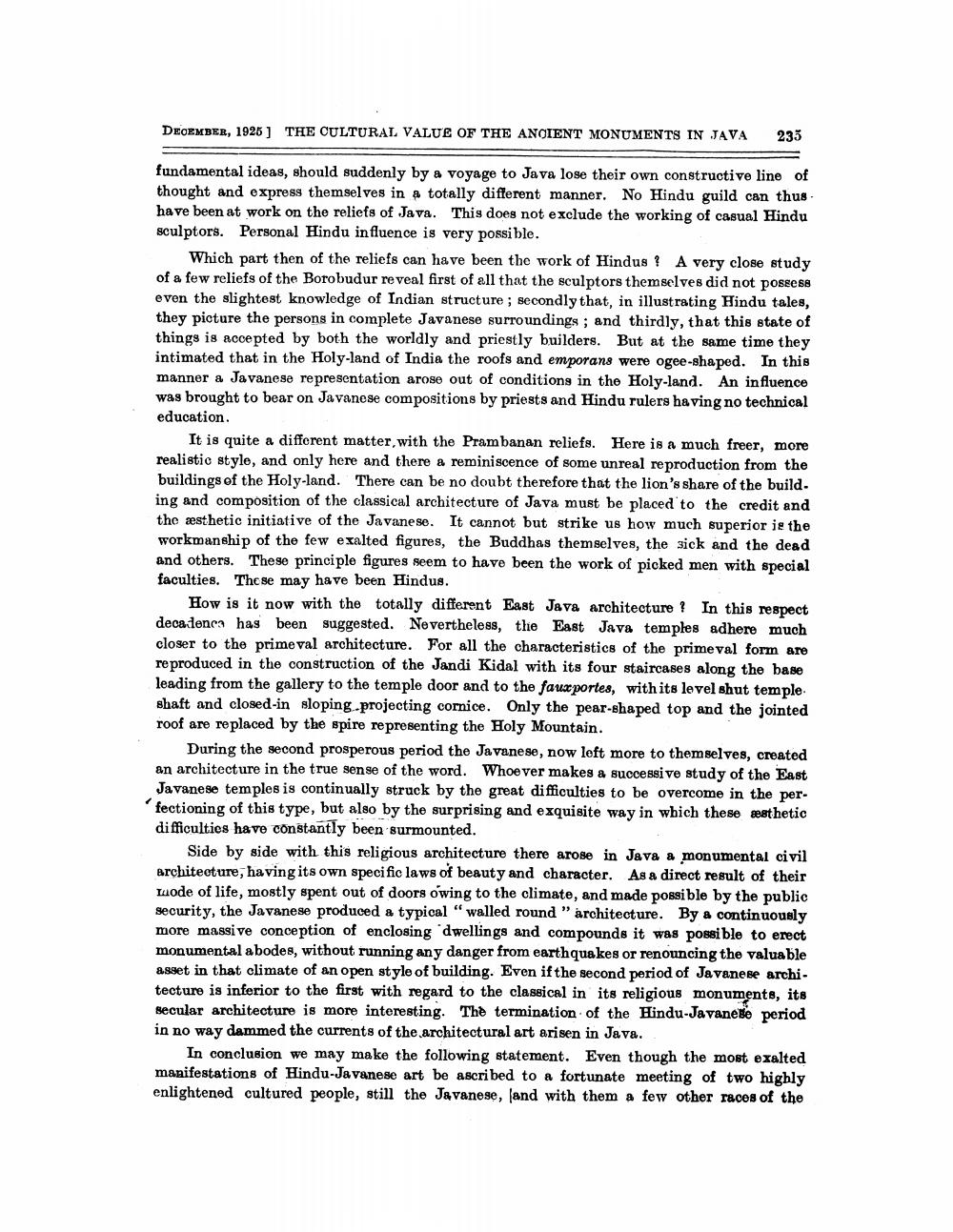________________
DECEMBER, 1925 ] THE CULTURAL VALUE OF THE ANCIENT MONUMENTS IN JAVA
235
fundamental ideas, should suddenly by a voyage to Java lose their own constructive line of thought and express themselves in a totally different manner. No Hindu guild can thushave been at work on the reliefs of Java. This does not exclude the working of casual Hindu sculptors. Personal Hindu influence is very possible.
Which part then of the reliefs can have been the work of Hindus? A very close study of a few reliefs of the Borobudur reveal first of all that the sculptors themselves did not possess even the slightest knowledge of Indian structure ; secondly that, in illustrating Hindu tales, they picture the persons in complete Javanese surroundings; and thirdly, that this state of things is accepted by both the worldly and priestly builders. But at the same time they intimated that in the Holy-land of India the roofs and emporans were ogee-shaped. In this manner a Javanese representation arose out of conditions in the Holy-land. An influence was brought to bear on Javanese compositions by priests and Hindu rulers having no technical education.
It is quite a different matter with the Prambanan reliefs. Here is a much freer, more realistic style, and only here and there & reminiscence of some unreal reproduction from the buildings of the Holy-land. There can be no doubt therefore that the lion's share of the build. ing and composition of the classical architecture of Java must be placed to the credit and the aesthetic initiative of the Javanese. It cannot but strike us how much superior ie the workmanship of the few exalted figures, the Buddhas themselves, the sick and the dead and others. These principle figures seem to have been the work of picked men with special faculties. These may have been Hindus.
How is it now with the totally different East Java architecture? In this respect decadenca has been suggested. Nevertheless, the East Java temples adhere much closer to the primeval architecture. For all the characteristics of the primeval form are re produced in the construction of the Jandi Kidal with its four staircases along the base leading from the gallery to the temple door and to the faux portes, with its level shut temple shaft and closed-in sloping projecting cornice. Only the pear-shaped top and the jointed roof are replaced by the spire representing the Holy Mountain.
During the second prosperous period the Javanese, now left more to themselves, created an architecture in the true sense of the word. Whoever makes a successive study of the East
Javanese temples is continually struck by the great difficulties to be overcome in the per'fectioning of this type, but also by the surprising and exquisite way in which these esthetic difficulties have constantly been surmounted.
Side by side with this religious architecture there arose in Java a monumental civil architecture, having its own specific laws of beauty and character. As a direct result of their mode of life, mostly spent out of doors owing to the climate, and made possible by the public security, the Javanese produced a typical "walled round "architecture. By a continuously more massive conception of enclosing dwellings and compounds it was possible to erect monumental abodes, without running any danger from earthquakes or renouncing the valuable asset in that climate of an open style of building. Even if the second period of Javanese architecture is inferior to the first with regard to the classical in its religious monuments, its secular architecture is more interesting. The termination of the Hindu-Javanese period in no way dammed the currents of the architectural art arisen in Java.
In conclusion we may make the following statement. Even though the most exalted manifestations of Hindu-Javanese art be ascribed to a fortunate meeting of two highly enlightened cultured people, still the Javanese, and with them a few other races of the




